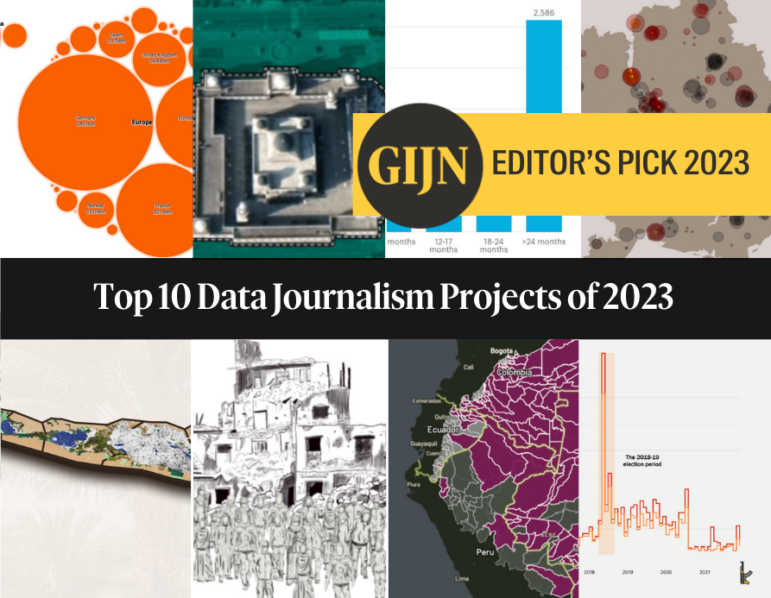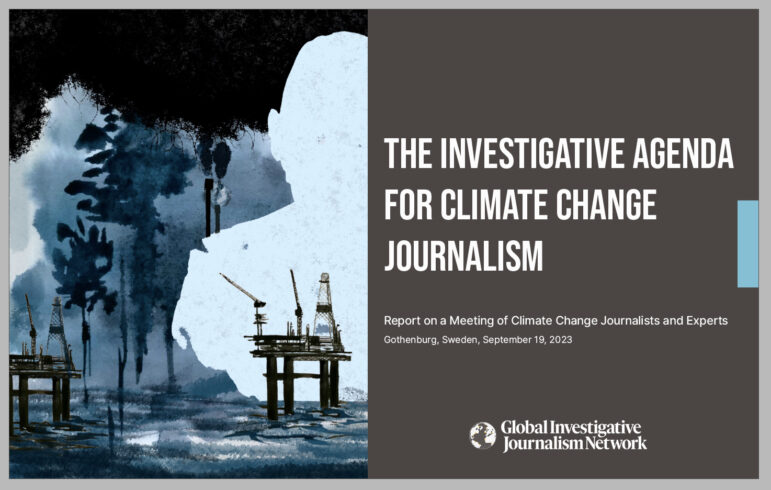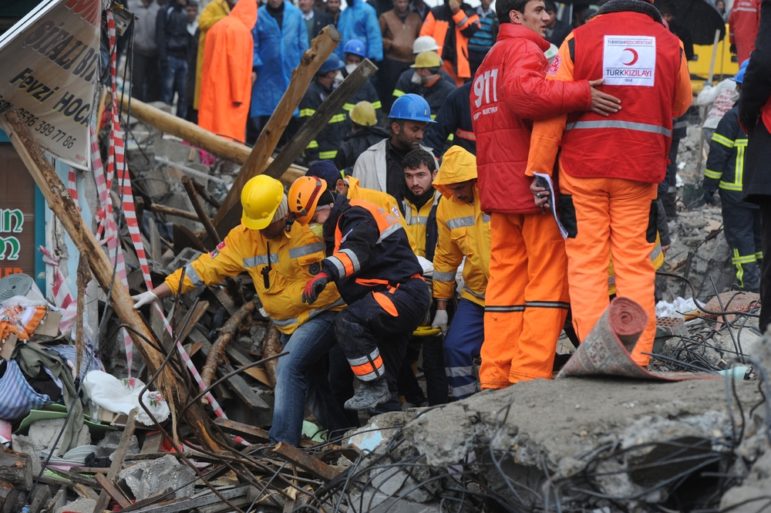

Image: GIJN
Editor’s Pick: Top 10 Data Journalism Projects from 2023
It’s been a bumper year for data journalism, with data journalists around the world digging into and analyzing a wide variety of topics and significant far-reaching events. These include stories on climate and weather, pollution, algorithms, war and conflict, the Turkey-Syria earthquake, and the deadliest migrant shipwreck in the Mediterranean in recent history.
In 2023, we published 36 editions of GIJN’s Data Journalism Top 10 column — which rounds up the most interesting and ambitious data journalism projects our staff have come across. In this edition, we are highlighting items handpicked from this year’s columns, with one exception. It was a pretty impossible task to narrow down the incredible range of projects to the very (and highly subjective) best, but the items we’ve chosen have either unearthed egregious issues that resonate globally, involved a great deal of legwork, or are innovative in topic or methods.
There are also several data investigations included in our annual Editor’s Pick series that are equally noteworthy but not listed here. Among them are the collaborative Forever Pollution Project and Rappler’s look at diplomatic impunity.
Modification and Demolition of Mosques in China
According to Human Rights Watch, there is a “systematic effort to curb the practice of Islam in China” and part of that effort involves demolishing mosques and altering their facades. The Financial Times built a dataset of 4,450 reported locations of mosques across China by combining search results from Baidu Maps, Google Maps, and OpenStreetMap, as well as data from the Australian Strategic Policy Institute. By analyzing the satellite imagery of these locations, the team identified 2,312 mosques with Islamic architecture. They found that three-quarters of these religious buildings had either been modified or destroyed between 2018 and 2023. By juxtaposing before-and-after images, journalists showed how the Arabic features of mosques, such as domes and minarets, were either stripped or covered up with traditional Chinese designs.
Airline Near Mishaps
The good news for the airline industry: flight traffic is bouncing back post-pandemic. Bad news: The New York Times is sounding the alarm on potential disasters. By analyzing internal records and safety reports from the United States Federal Aviation Administration as well as interviewing more than 50 current and former pilots, air traffic controllers, and federal officials, the team found that safety lapses and near-collisions between planes are happening more and more frequently along US runways. These incidents, which often occurred at or near airports, were mostly due to human errors exarcebated by a nationwide staffing shortage.
War and Conflict
Russia’s war in Ukraine, the civil unrest in Myanmar, and recently the conflict in Israel and Gaza have peppered news headlines in 2023. Here we highlight three pieces that showcase varying data methods for investigating these wars.
Russia/Ukraine: Independent Russian news outlet Mediazona tried to find out how many Russians fighting in Ukraine are former inmates. The problem: the Federal Penitentiary Service stopped publishing reliable data on the prison population soon after it was reported that the Wagner group of mercenaries was recruiting inside Russian jails. So instead, reporters scoured local incarceration statistics from 35 out of 58 regions in the country to find out how the prison population had changed and which parts of Russia have seen the greatest drops. Mediazona also analyzed data from the websites of Russian military courts in an attempt to gauge how many of its soldiers have deserted the army.
Israel/Gaza: Al Jazeera’s visualization Know Their Names used data from the Palestinian Ministry of Health to detail the 6,747 people killed between October 7 and 25 as a result of the initial Israeli attacks on Gaza. Reporters visualized the ages of those who died to show how many years they’ve lost based on the rate of life expectancy. They also highlighted just how many families suffered losses of multiple family members in the conflict.
Myanmar: In this New York Times investigation, reporters combined photographs and videos, data, satellite images, and interviews to show that the Myanmar junta’s retaliation against citizen resistance has become increasingly fierce since the 2021 coup and civilians are often on the receiving end of the violence. The Times found there were nearly twice as many military airstrikes in April, May, and June as compared to the first three months of this past year. In addition, air attacks have gone from an average of eight per month in 2021 to 30 in 2023.
Algorithmic Bias
Every year thousands of welfare recipients in the Dutch city of Rotterdam are put under investigation on suspicion of committing benefits fraud. This detailed investigation by Lighthouse Reports and WIRED used freedom of information laws to obtain the city’s fraud algorithm and the data behind it. Journalists found that up until 2021, the city was using a system that “discriminates based on ethnicity and gender.” According to their report’s analysis, switching just a few key identity markers — such as age, gender, and if you have children — can have a significant impact on someone’s risk ranking, triggering a potentially invasive fraud investigation. Rotterdam is just one of many cities using algorithms to flag and then interrogate welfare recipients, and was chosen because reporters were given “unprecedented access” to the city’s machine learning model. Read more about the detailed methodology for this investigation here.
Misuse of Climate Finance Funds
Developed nations have committed to channeling some US$100 billion per year to finance activities in developing countries that aim to mitigate or adapt to the effects of climate change. In an effort to track accountability of these pledges, Reuters and Stanford University’s Big Local News examined thousands of records that countries submitted to the UN to document climate finance contributions. Journalists found a concerning lack of transparency and details in these reports, as well as projects that seem to have little or nothing to do with reducing emissions or managing the effects of climate change.
Mapping the Amazon’s Underworld
Amazon Underworld is a collaborative cross-border investigation into the power dynamics playing out in the world’s largest rainforest. A team of 37 reporters from InfoAmazonia, LigaNoSilencio, and Armando.Info spent 15 months on field reporting and data analysis, using primary sources, satellite imagery, information requests, and official documents from Brazil, Colombia, Venezuela, Peru, Ecuador, and Bolivia to map out the regional criminal ecosystem. They created a database and interactive map of the groups profiting from crime and instability in the region, where “porous and difficult to control borderlands are marked by an obscure convergence of guerrilla movements, criminal startups, and multinational organized crime.”
Desertification of an Egyptian Oasis
Siwa Oasis, an urban oasis in Egypt, is suffering from many environmental issues. Unsustainable agricultural practices have resulted in a large proportion of cultivated areas becoming waterlogged and salinized, which has led to a deterioration in land productivity. Using satellite imagery, ARIJ Network mapped and tracked the degradation of the oasis over three decades. In Arabic.
Extrajudicial Killings in Bangladesh
According to Bangladeshi human rights researchers, the country’s security forces were involved in the deaths of 2,597 people between 2009 and 2022 — which Netra News notes is “almost certainly” an undercount. To go with a special report into extrajudicial killings, fatal shootings, and custodial torture, Netra News built a sophisticated database for these grim figures — searchable by name, location, and the security agency involved, such as police, army, or anti-terrorism battalions. The data and the reporting also discern geographic trends in killings and explain huge spikes of deaths in 2013-14 and 2018-19 related to elections and opposition protests. (While the government did not respond to this investigation, reporters noted the “Bangladesh authorities have long denied that its security forces carry out extrajudicial executions.”)
Ukrainian Artifacts in Russia
Ukrainian data journalism agency Texty.org.ua set out to find artifacts originating from the territory of modern-day Ukraine that have been moved to Russia prior to Ukraine’s independence. The team studied open source data on Russian museum collections and managed to identify 110,000 exhibits in two Russian museums that could be traced back to locations in Ukraine. The items included parts of ceramic pots, tools, and other items made of gold, silver, and precious stones. The story is available in English and in Ukrainian.
Dangerous Breathing Machines
Breathing machines and ventilators are used to treat sleep apnea — where a person’s airway can collapse at night — alongside many other conditions. From the nonprofit newsroom ProPublica, in collaboration with the Pittsburgh Post-Gazette, comes this deep-dive investigation into how one industry-leading company handled complaints that a foam product used inside its devices had released “black particles” or “dirt and dust” inside the machines. Reporters used newly unsealed court records, internal documents, text messages, public records, and conducted more than 200 interviews to investigate. (In response the company said it began addressing the problem as soon as it was aware of it and regretted the “distress and concern” caused by the recall, but that complaints were limited in the years before the devices were recalled.) Read the reporters’ how-they-did it explainer here.
Bonus Item: Swift Sets the Scene
American singer-songwriter and entrepreneur Taylor Swift is TIME’s 2023 Person of the Year. Just this year, she has broken her own Spotify streaming record, dominated music charts, and performed in the highest grossing tour of all time. Data journalists and fans (nicknamed Swifties) did not pass up the opportunity to track, map, and visualize Swift’s undertakings. See: USA Today’s visual look at Swift’s tour and setlist, Reuter’s examination of what makes Swift’s songs so popular, Bloomberg’s “definitive” account of where her fortune comes from, Wall Street Journal’s analysis of what it takes to be in the top one percent of Swifties on Spotify, and a fan’s mapping of her stage movements.
GIJN’s Data Journalism Top 10 list is curated fortnightly. Make sure we don’t miss a great data story and send your suggestions to us. The column will take a break and return on January 19, 2024.
 Eunice Au is GIJN’s global team manager based in Budapest, Hungary. Previously, she was a Malaysia correspondent for Singapore’s The Straits Times, and a journalist at Malaysia’s New Straits Times. She has also written for The Sun, Malaysian Today, and Madam Chair.
Eunice Au is GIJN’s global team manager based in Budapest, Hungary. Previously, she was a Malaysia correspondent for Singapore’s The Straits Times, and a journalist at Malaysia’s New Straits Times. She has also written for The Sun, Malaysian Today, and Madam Chair.




















